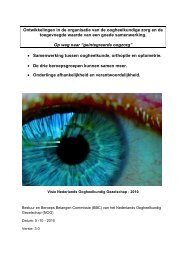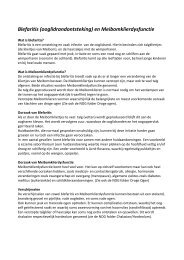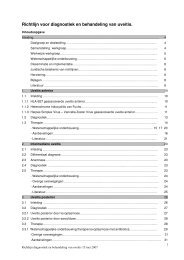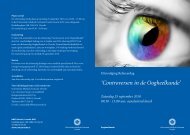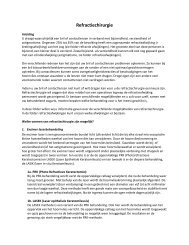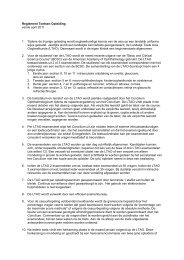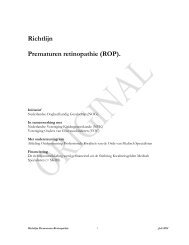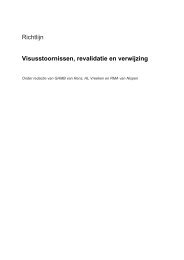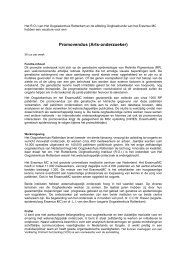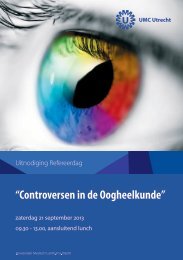terminology and guidelines for glaucoma ii - Kwaliteitskoepel
terminology and guidelines for glaucoma ii - Kwaliteitskoepel
terminology and guidelines for glaucoma ii - Kwaliteitskoepel
Create successful ePaper yourself
Turn your PDF publications into a flip-book with our unique Google optimized e-Paper software.
A retinal sensitivity value worse than normal is indicated by a negative symbol in Humphrey perimeters (mean deviation)<br />
<strong>and</strong> a positive symbol in Octopus perimeters (mean defect).<br />
• PSD or LV (pattern st<strong>and</strong>ard deviation or loss variance): this is the st<strong>and</strong>ard deviation or variance of the deviations<br />
<strong>and</strong> is thus a measure of the degree to which the shape of a patient’s field differs from a normal, age-corrected, reference<br />
field. Thus the PSD or LV indicate the extent of focal loss in the visual field. The PSD or LV can be normal in<br />
cases where there is diffuse loss <strong>and</strong> they are not good indices <strong>for</strong> the follow up of advanced <strong>glaucoma</strong>.<br />
•SF (short term fluctuation): this indicates variability during a test at points that are tested twice; it is generally higher<br />
in fields with <strong>glaucoma</strong>tous damage. SF is thus an index of the patient’s consistency during the test period.<br />
•CPSD or CLV (corrected pattern st<strong>and</strong>ard deviation or corrected loss variance): this indicates the extent of focal loss<br />
in the visual field, taking short term fluctuation into account.<br />
•Probability indices : abnormal global indices are presented with a probability denoted p < ‘x’%, indicating that there<br />
is ‘an ‘x’% chance that this index is in reality normal.<br />
Bebié Curve or Cumulative Defect Curve (Octopus, Peridata): the 59 points tested at full threshold (in the G1 program) are<br />
ranked from the highest to the lowest sensitivity after age correction. A curve is obtained where the points on the left<br />
represent the better points in the visual field <strong>and</strong> those on the right the worse points 13 .<br />
When the sensitivity loss is diffuse most of or all the curve is not within the 95% prediction interval of the<br />
normal population curve.<br />
When the sensitivity loss is localised, <strong>and</strong> the sensitivity at some points is normal <strong>and</strong> at others abnormal, the<br />
patient’s curve is within normal limits on the left <strong>and</strong> drops down sharply to the right.<br />
Glaucoma hemifield test: this compares each of 5 groups of test points tested in a hemifield with the corresponding group<br />
in the opposite hemifield. It is reported as abnormal, borderline or normal 14 .<br />
DIAGNOSTIC CRITERIA FOR GLAUCOMATOUS VISUAL FIELD LOSS<br />
(in the absence of retinal or neurological disease affecting visual field)<br />
Visual field loss is considered significant when:<br />
a) abnormal Glaucoma Hemifield Test, confirmed on two consecutive tests 15 , or<br />
b) 3 abnormal points confirmed on two consecutive tests, with p < 5% probability<br />
of being normal,<br />
one of which should have p < 1%, all being not contiguous with the blind spot,<br />
c) CPSD < 5% if the visual field is otherwise normal, confirmed on two consecutive tests.<br />
Any defect or suspected defect must be confirmed by repeated testing.<br />
1.4.4 - GRADING SYSTEMS 16<br />
Scoring based on defect extent <strong>and</strong> on proximity of the defect to fixation point<br />
Hodapp <strong>and</strong> co-workers proposed a classification in three stages considering MD value, number of depressed test sites on<br />
the pattern deviation map <strong>and</strong> the presence of defect sites within the central 5°. This type of scoring needs an accurate<br />
analysis of visual field which is useful but time-consuming 17 . It emphasizes the closeness of defective points to the fixation.<br />
Grading based on kinetic perimetry<br />
Aulhorn <strong>and</strong> Kermeyer ‘s classification based on kinetic <strong>and</strong> profile static perimetry patterns includes five stages of<br />
increasing severity, according to visual field defects extension <strong>and</strong> morphology 18 .<br />
Ch. 1 - 27 EGS



